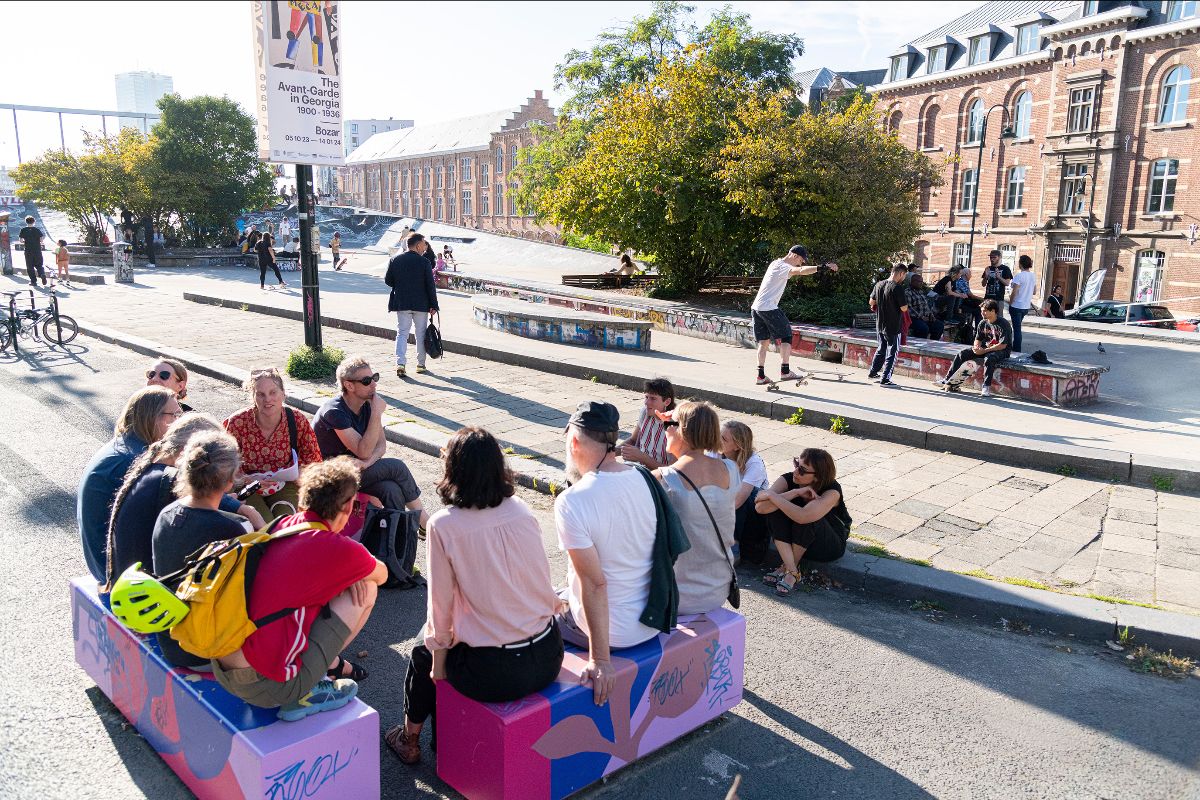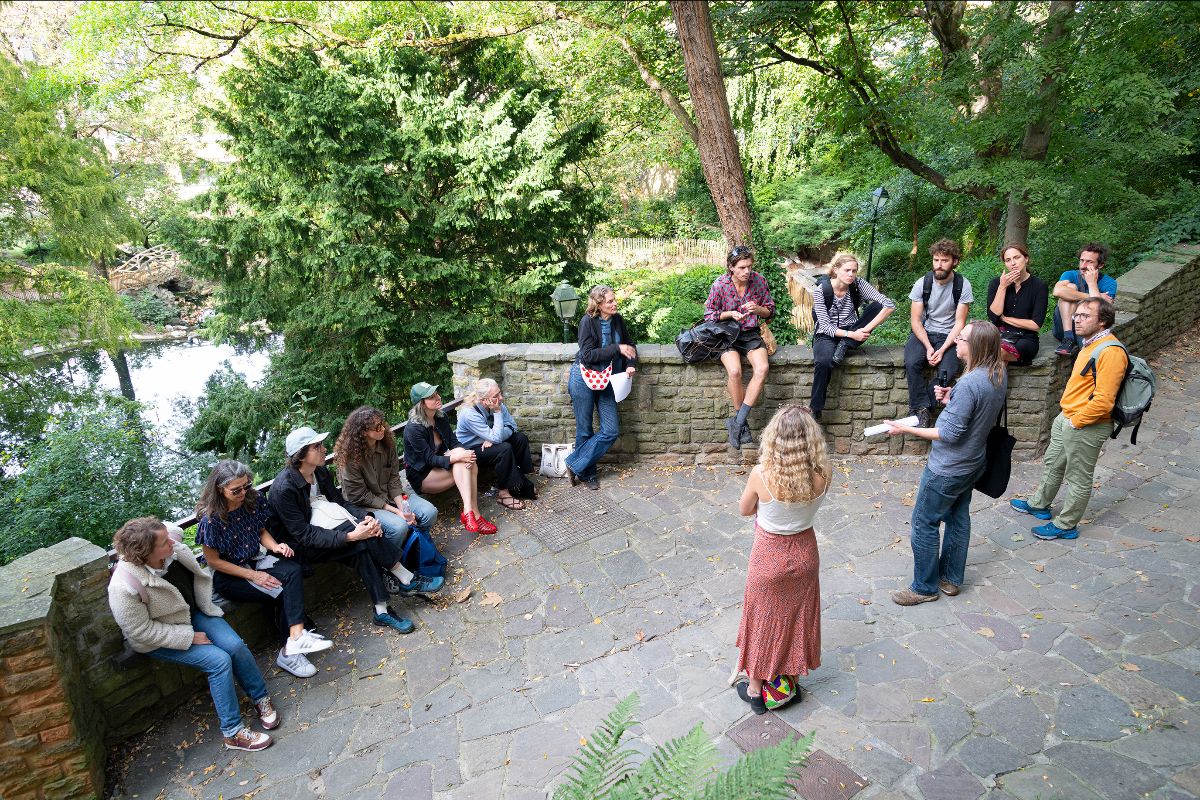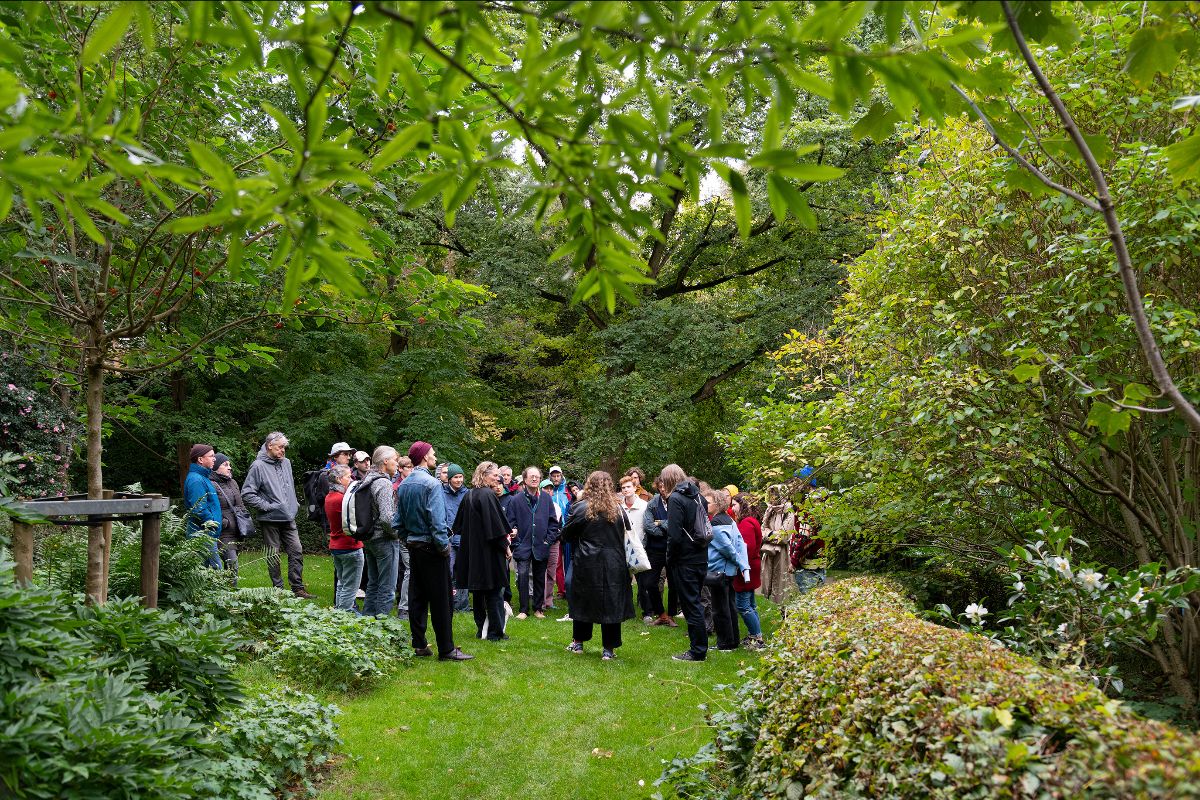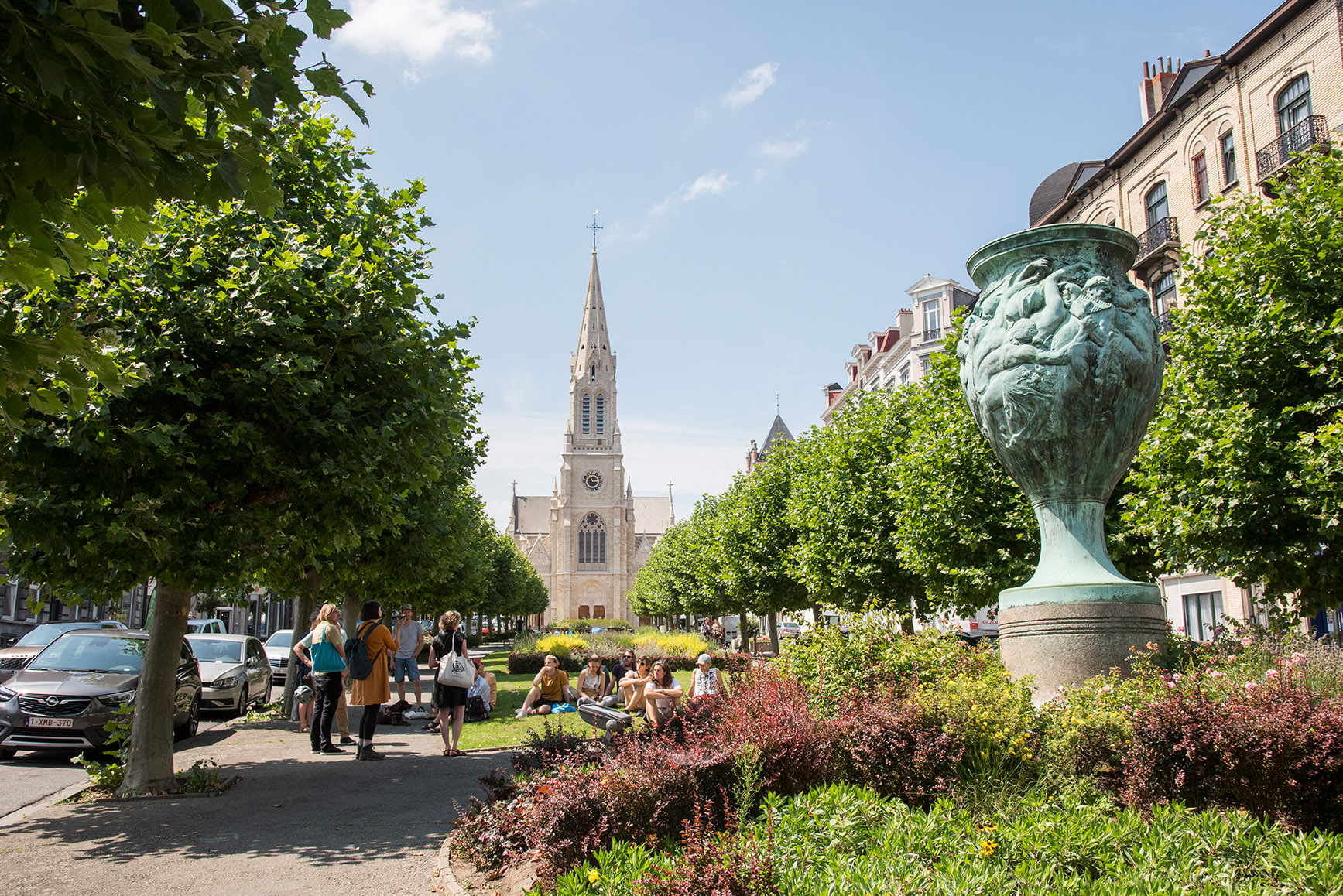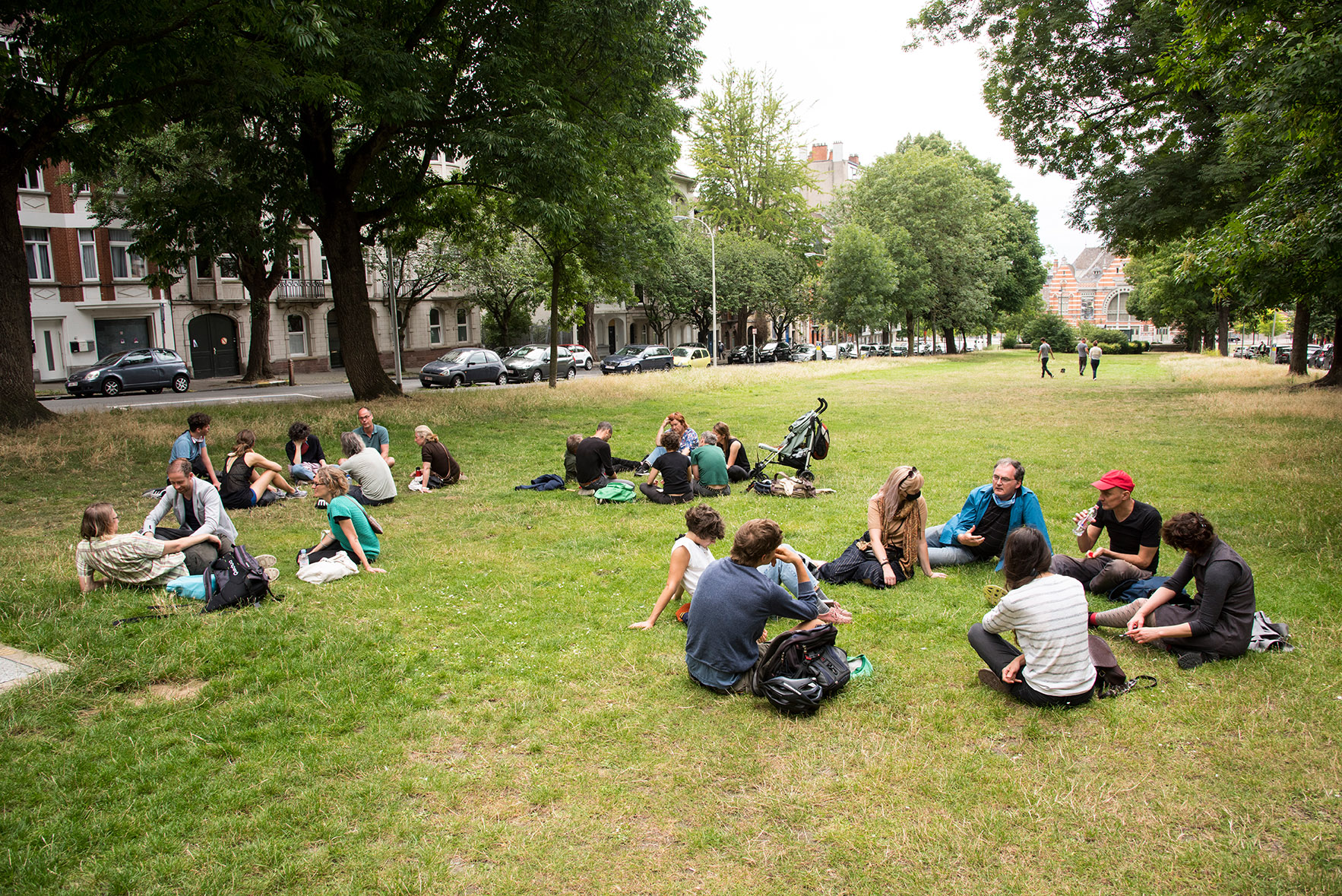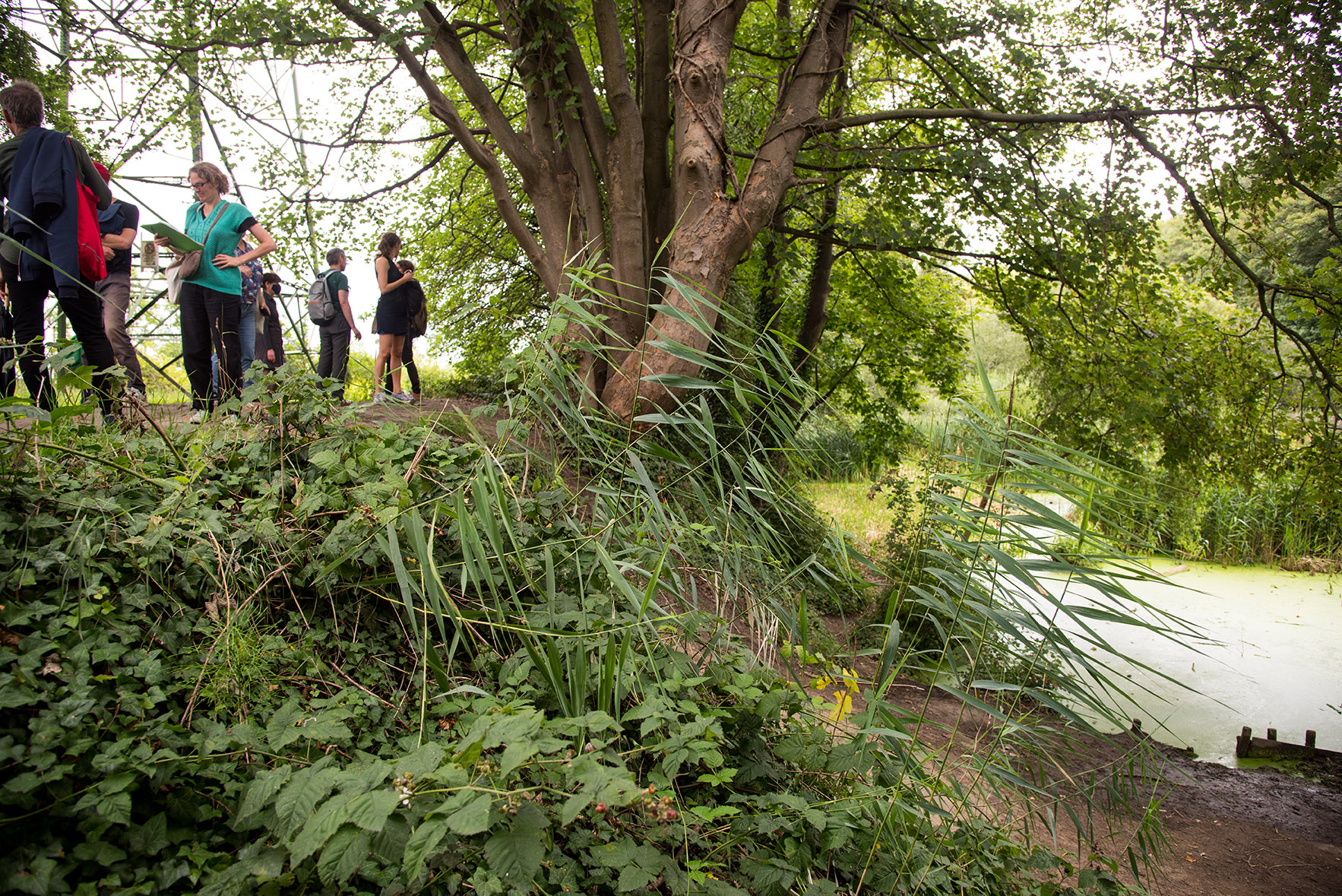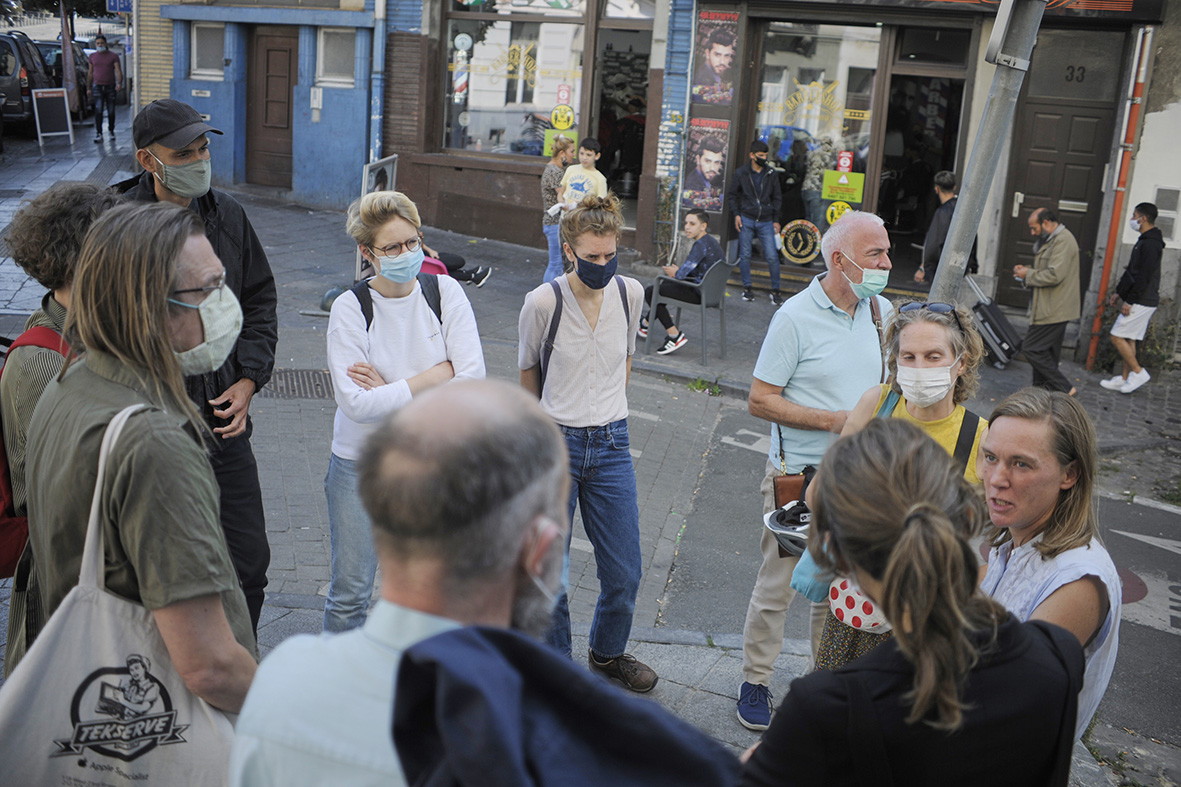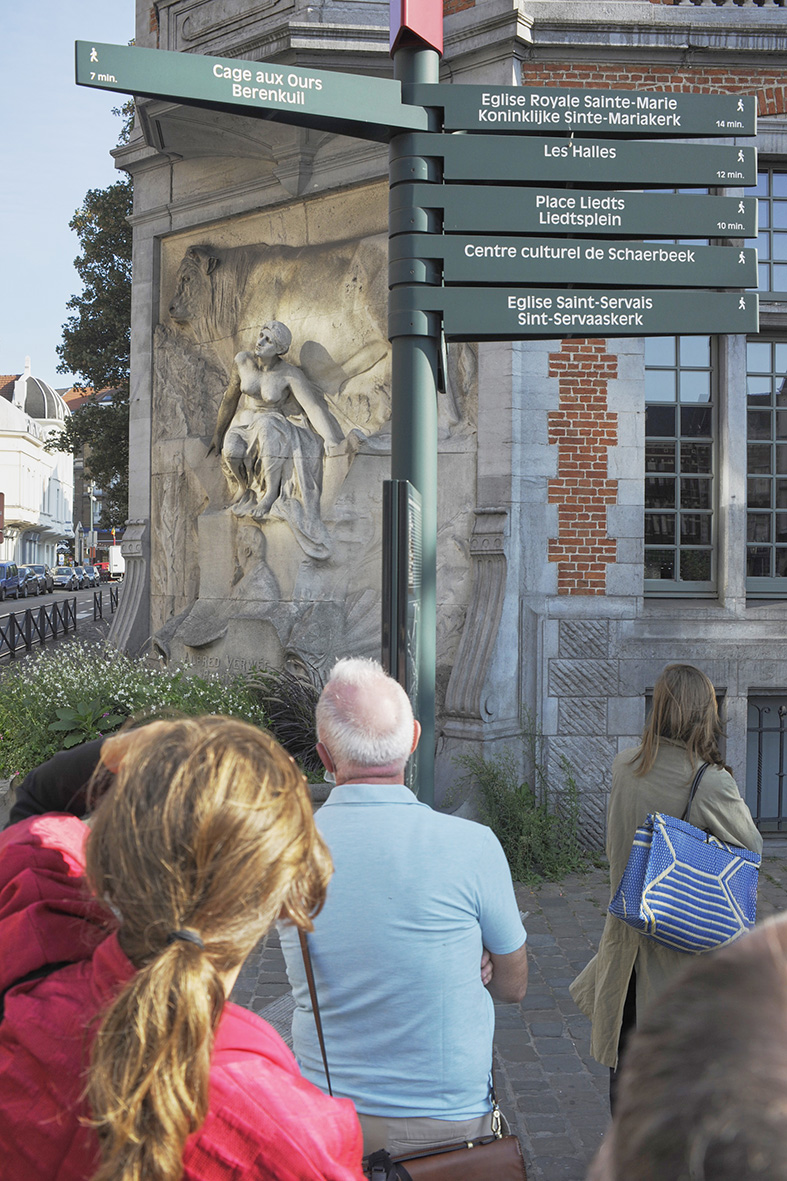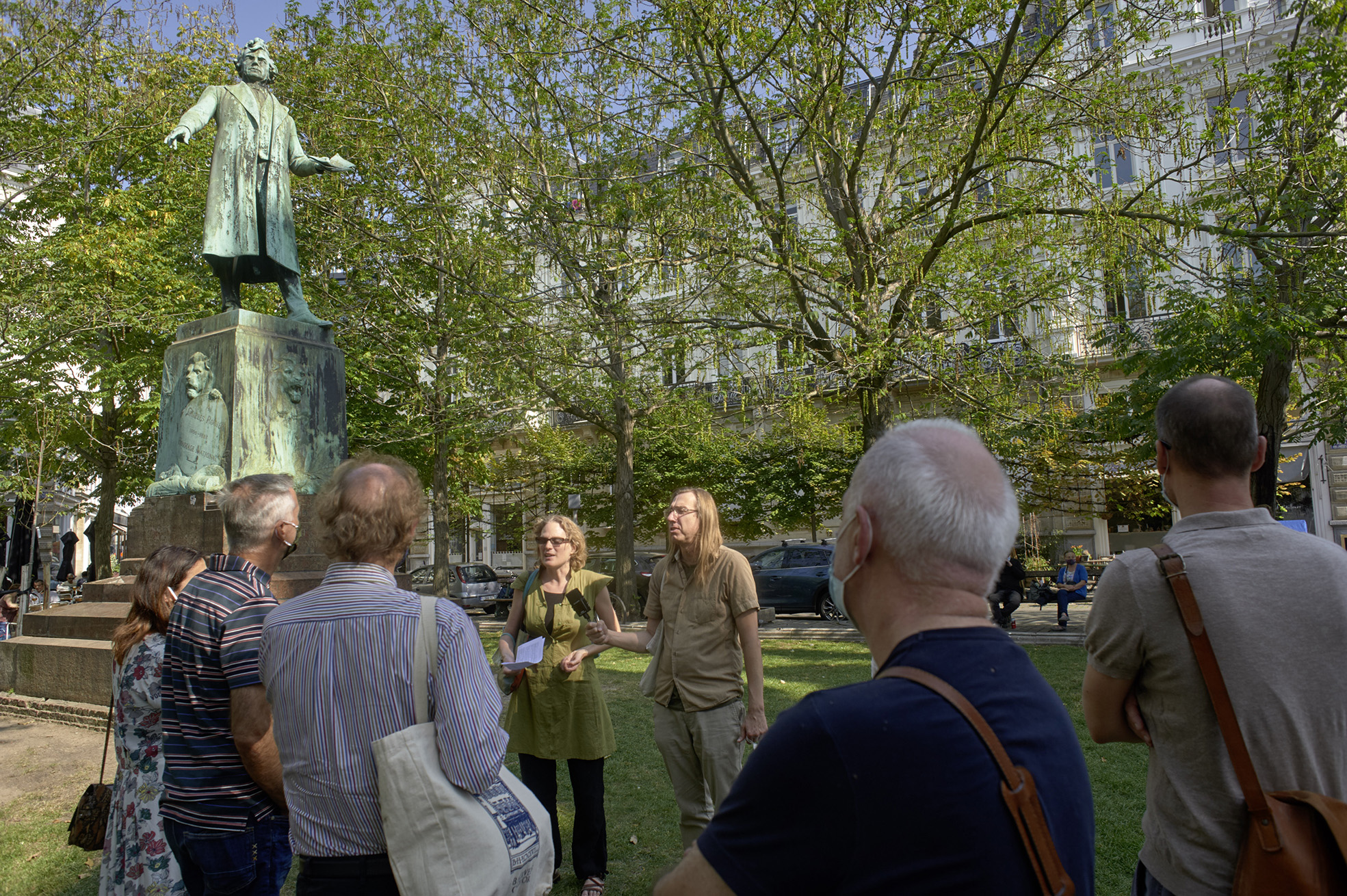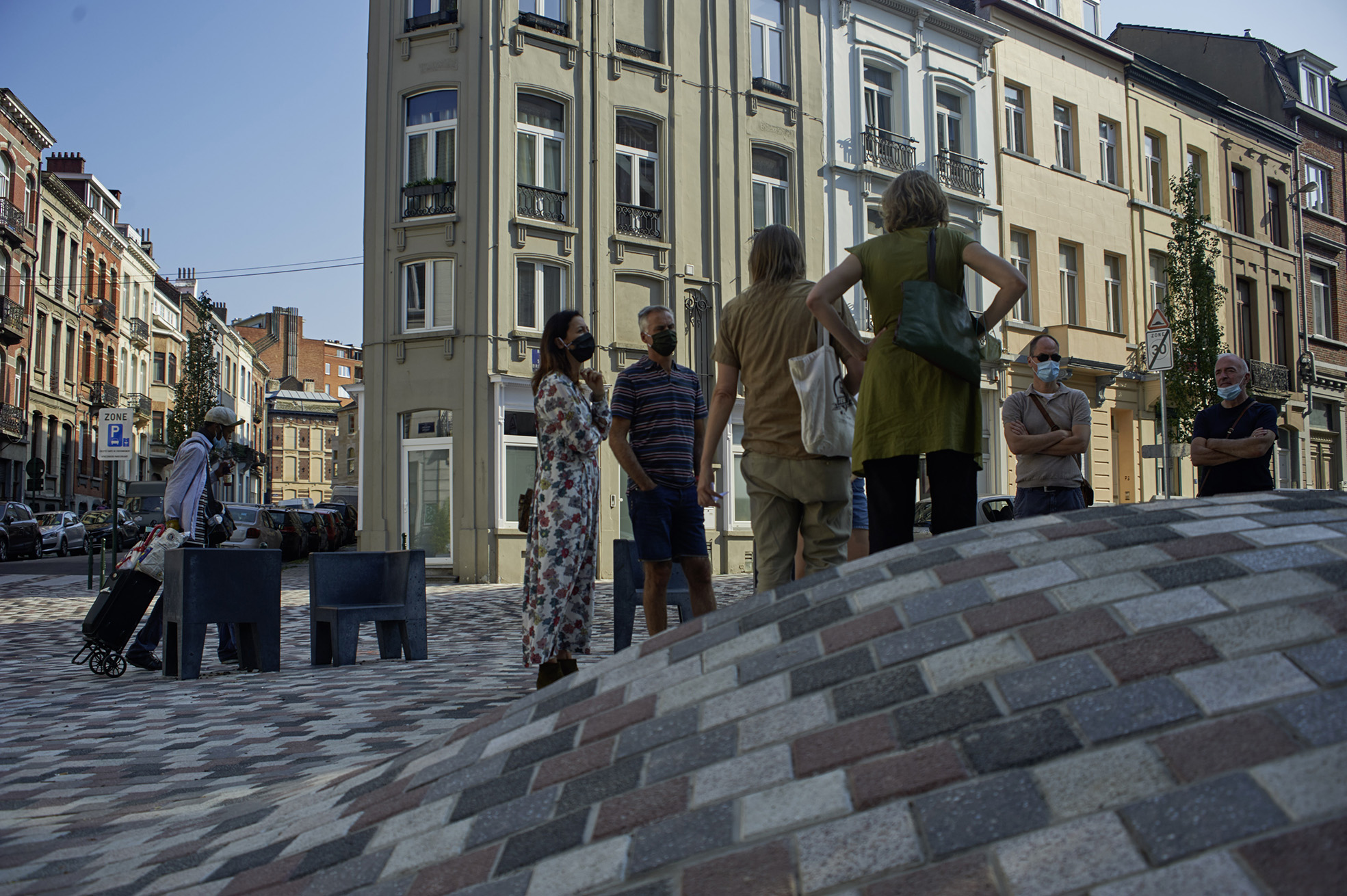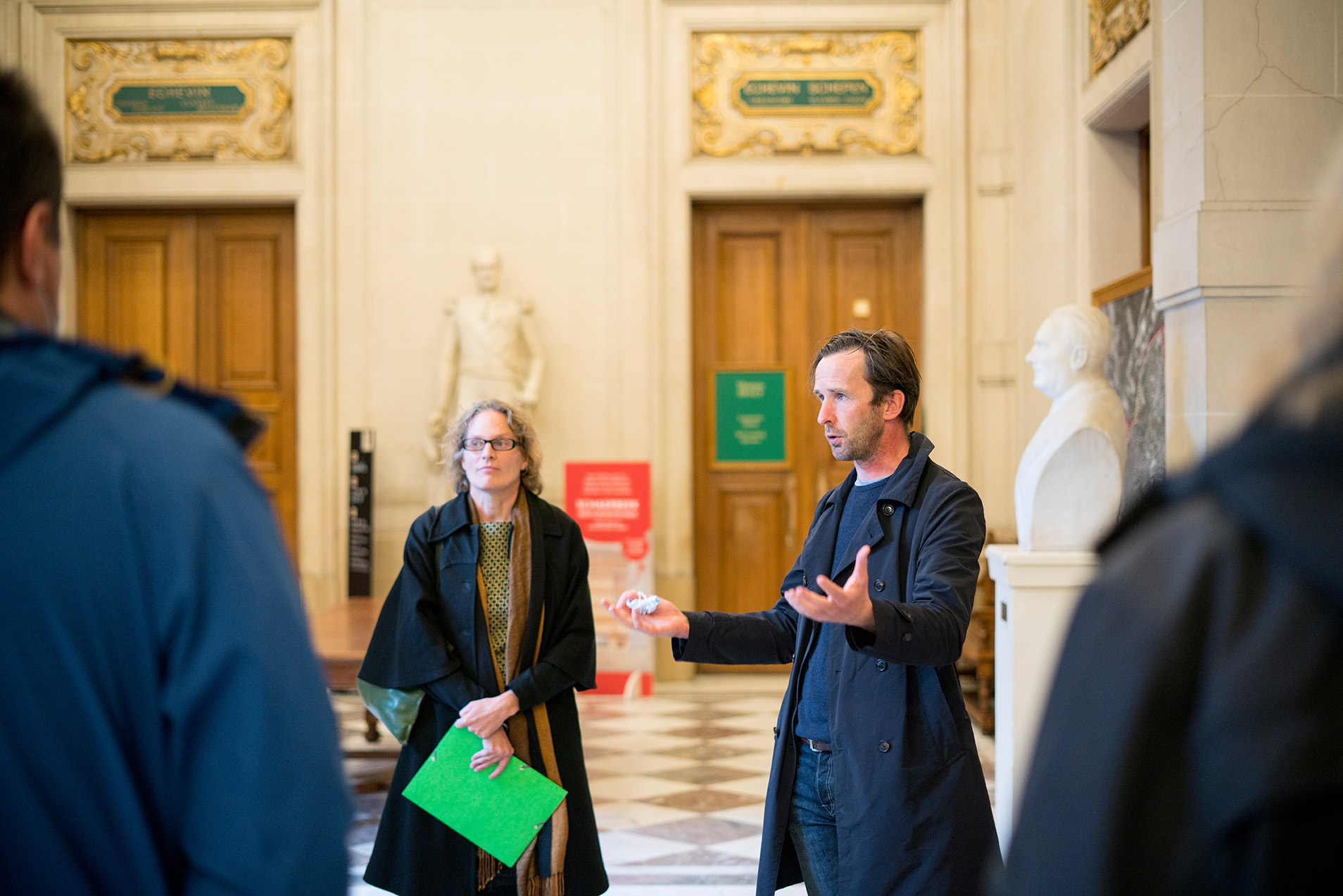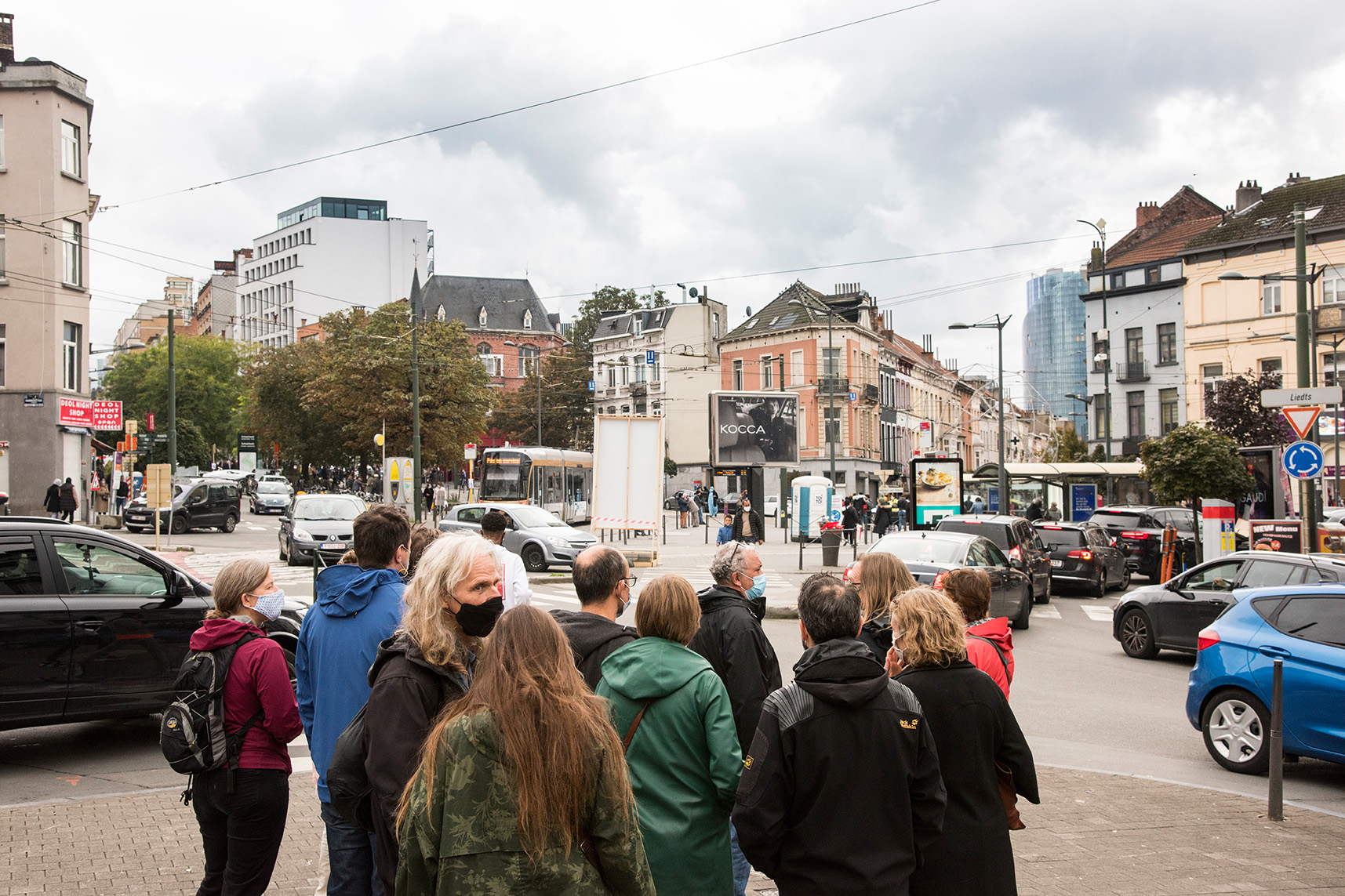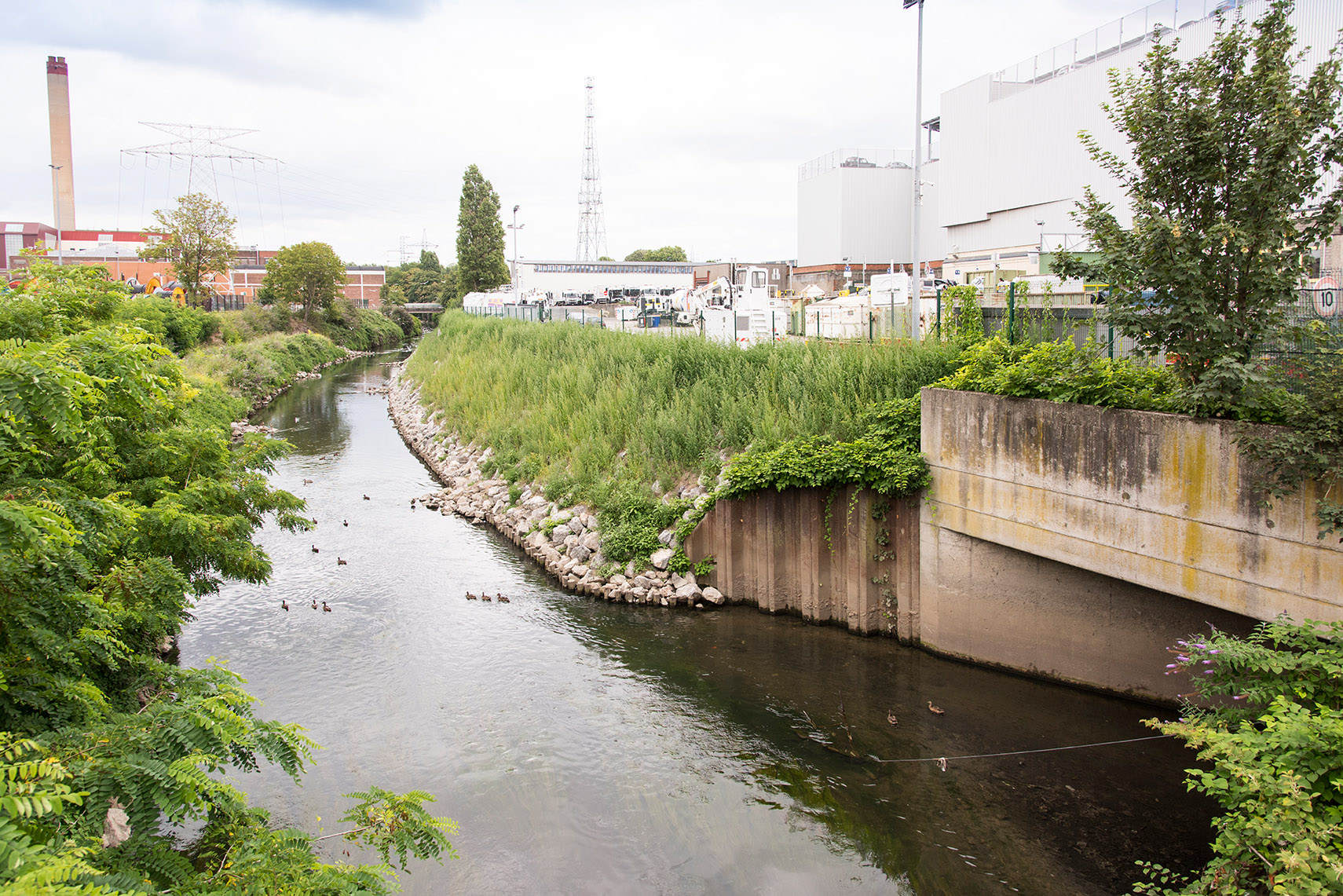7 Walks (learning through the soles of our feet)
Solo exhibition by Vermeir & Heiremans at n0dine, Brussels
22/09 September – 15/10/2023
Opening: 21/09/2023
Vermeir & Heiremans in collaboration with David Aubin, Margot Elmer, Emily Rosamond.
7 Walks (Learning Through the Soles of our Feet) is a co-production of nadine vzw and Jubilee vzw. Many thanks to the Service des Archives, patrimoine et réserve précieuse of the Université libre de Bruxelles. Supported by the Flemish Community.
Three public walks on 1, 8, 15/10/2023, 14-18h (for details, see below):
01/10/2023: WALK #01 – Brussels city centre
The geographer who didn’t like maps
08/10/2023: WALK #02_Saint-Gilles
A source for value distribution? From a cooperative for drinking water to an Rationalist Orphanage
15/10/2023: WALK #03_Ixelles
Little rivers together make big streams. The world as a work of art
Learning Through the Soles of our Feet
7 Walks is an artistic research trajectory in collaboration with guest walkers and participants. Using walking as a public research method and developing a direct relation with the natural or urban environment, the project aims to connect the ecology of the arts with a natural common good – water.
Vermeir & Heiremans develop three new walks in Brussels for nadine, initiating a dialogue on concepts such as ownership, public goods and governance, and exploring forms of value redistribution and mutualism. At the same time, they examine cartography from an alternative pedagogical perspective.
The walks activate the archival documents that the artists present in nadine’s exhibition space. These documents are a generous loan from the Service des Archives, patrimoine et réserve précieuse of the Université libre de Bruxelles. They highlight the role of anarchist and geographer Élisée Reclus (1830-1905) within the Université Nouvelle and the Institut des Hautes Etudes. These institutions were founded in Brussels in 1894 by progressive thinkers and dissident ULB professors after Reclus’ invitation to teach geography at the Université libre was cancelled for fear of reputational damage in connection with Reclus’ anarchist views and sympathies.
The self-organized Université Nouvelle became an international meeting point where Élisée Reclus, as well as neo-impressionist artists, writers, lawyers, activists and progressive politicians taught. The Institut des Hautes Etudes offered free adult education with the emancipation of workers and students in mind. In this context Reclus set up the Institut Géographique.
Geography takes up a central role in alternative learning, with walking as a didactic method. The great tradition of anarchist education swears by the axiom that the best learning happens… through the Soles of our Feet. Anarchist geography saw 2D maps as a means of creating dependent subjects rather than empowered citizens. Reclus did not like 2D maps either, instead his teaching started from the observation of the nearest stream. Based on his book Histoire d’un ruisseau (1869) he practiced an intuitive geography, one that was in direct contact with its environment.
Vermeir & Heiremans gladly take up this advice in their walks to observe the Brussels’ waters: the sources, drinking fountains, lakes and the invisibilized vaulted rivers.
Next to historical documents the artists have installed a giant globe hanging from the ceiling of the exhibition space, with a printed image of the earth derived from powerful NASA satellite data. We see the earth and its fragile envelop, the atmosphere, showing us weather patterns from space.
Creating a giant globe was one of the dreams Reclus wanted to realize: a realistic representation of the world, devoid of boundaries, meridians and abstract cartographic symbols. According to Reclus, “the globe outdoes the map by nature of its truthfulness: it represents the planet in its true structure, it varies exactly according to the real contours, whereas maps, increasingly false as they are applied to greater parts of the planetary surface, can only deceive the viewer regarding the relative dimensions of different regions while on the curvature of an artificial globe it is impossible to err with regard to the relative area of the various terrestrial entities”[1]. Flat 2D maps deform countries and continents due to their chosen projections. Those maps reflect the power of the person or state who commissioned the map. Therefore, Reclus’ Institut Géographique created small globes and 3D maps for schools promoting alternative education.
Today we can assemble the wealth of photographic information on a variety of reality maps and globes. One can retrace these maps and globes to one picture that revolutionized our view of the world. In 1972 NASA distributed AS-17-148-22727, the first photograph that showed the complete earth, emancipating itself from earlier cartographic conventions, or so it seemed. In fact, the picture has been re-oriented by NASA. The original picture shows the south side up, and the continents ‘upside-down’. NASA also cut out the globe from the black cosmos and re-entered it in close-up in the middle of the image.[2]
Why did NASA re-orient the globe with north on top? Even Élisée Reclus represented the earth in that way. It is a cartographic reasoning. In order to find oneself on the earth, north is placed upwards, and so the map, as a powerful concept, is re-surfacing again. Despite itself, AS-17-148-22727 became a map. Cartography seems so ingrained in our brains. How can the world be made visible, as it is and not as we think it is? How can the cartographer disappear? How can the vast empty space of the cosmos be visible, and the fragile tiny earth in it?
To make the cartographer disappear was Reclus’ motivation to create a Great Globe at the scale of 1/100.000, resulting in a monumental object of 127,5 meters of diameter to be presented at the 1900 Paris World Fair. Reclus envisaged to appoint neo-impressionist artists to draw the color decoration for the enormous surface of the globe.[3] “The great symbolic power of that object, which was never realized, was an attempt to minimize as much as possible the dichotomy between the world and its representations, that is to make the world an artwork.”[4]
Reclus’ vision clearly merged art, geography and activism. A form of social geography in which one can act upon the world and be embedded in it, to (socially) reform it for all living beings. “The earth is infinitely beautiful, but for us to associate ourselves to its beauty, to glorify it by a respectful art, there is no other means but that of becoming free of instituting the decisive revolution against money and of ennobling the class-struggle by abolishing the classes themselves”.[5] Reclus warns us that ugliness is created by speculation and accumulation. The reason for that he saw in “the fact that everything can become private property.”[6]
Today the powerful NASA image has become a new type of map. Inside the virtual world of Earth 2, we rediscover the image as a geo-located Metaverse, in which a direct relation with where you are in the real world is created. Earth 2 is building “a pristine 1:1 scale digital replication of our planet Earth. Earth 2 is one of the most successful startups in history and has grown into the biggest Virtual Land Registry in the world with over 100 million tile land parcels sold.”[7]
In his short story ‘On Exactitude in Science’ (1946) Jorge Luis Borges describes the Cartographers Guilds who had struck a “Map of the Empire whose size was that of the Empire, and which coincided point for point with it”[8]. Later generations had allowed the map to fall in ruins. When in these 1:1 Metaverse Earths, the real earth and virtual earth are linked in the form of real estate parcels, and when intellectual, material and immaterial property converge, public space, the commons, movement and free speech might become severely restricted, opening up the possibility of the propertization of everything.[9]
The walks through Brussels question the dark side of all these forms of cartography as an infrastructure of power and surveillance, what occasionally becomes visible in the urban fabric. In these walks Vermeir & Heiremans address the possibility to co-create an emancipatory cartography, starting from artistic practices embedded in the landscape, a cartography that can generate new narratives, collaborations, mutualism and agency.
Footnotes
1. Reclus É., ‘Projet de construction d’un globe terrestre à l’échelle du cent-millième’, Paris, 1895, 3-4. in: Federico Ferretti, Pioneers of the History of Cartography: the Geneva map collection of Élisee Reclus and Charles Perron. Journal of Historical Geography, Elsevier, 2014, 43 (1), pp.85-95.
2. Gillet, A. AS17-148-22727 – Face à la Terre, Geogr. Helv., 70, 27–32, https://doi.org/10.5194/gh-70-27-2015, 2015.
3. Ferretti F., “Anarchism, geography and social art”, in C. Kosuch (ed.) Anarchist Avant-Garde, Amsterdam, Brill, 2019, 235-259, https://brill.com/view/book/edcoll/9789004410428/BP000013.xml, p15
4. Ibid.
5. Reclus É, ‘L’Art et le peuple’ (1904), in: F. Ferretti, “Anarchism, geography and social art”, in C. Kosuch (ed.) Anarchist Avant-Garde, Amsterdam, Brill, 2019, 235-259, https://brill.com/view/book/edcoll/9789004410428/BP000013.xml, p13
6. Reclus É., ‘Du Sentiment de la nature dans les sociétés modernes’ (1866), in: F. Ferretti, “Anarchism, geography and social art”, in C. Kosuch (ed.) Anarchist Avant-Garde, Amsterdam, Brill, 2019, 235-259, https://brill.com/view/book/edcoll/9789004410428/BP000013.xml, p13
7. https://earth2.io
8. Borges J.L., On Exactitude in Science, Collected Fictions, translated by Andrew Hurley
9. Vermeir & Heiremans, ‘Volatile properties: A Modest Proposal revisited’, Finance and Society 2023, 9(3): p75-90.
01/10/2023: WALK #01 – Brussels city centre
The geographer who didn’t like maps
We question walking as an experiential educational and artistic method as practised by the anarchist and geographer Elisée Reclus, as well as his attempts at appropriating maps as a tool of social geography instead of power and surveillance.
The walk starts from exhibition space n0dine where we highlight a number of documents we collected on Reclus, the Université Nouvelle and the Institut des Hautes Etudes. These institutions were founded by progressive thinkers and dissident professors after Reclus’ invitation to teach geography at the Université Libre was cancelled for fear of his anarchist sympathies.
We then look for the nearest river, the Zenne which, after many proposals and plans, was finally vaulted, and for which working-class neighbourhoods had to give way to stately avenues from 1865 onwards. We then walk past surprising places where historical characters lived or worked, including artists, writers, lawyers, geographers, politicians,…who played a decisive role in the creation and development of the Université Nouvelle. In the process they’ve put a social-emancipatory role of geography, art and education on the map.
practical:
Sunday 1 October 2023, 14-18h
Starting point: n0dine, Lakensestraat 105
Guest walker: Emily Rosamond
Reservations: loes@nadine.be
Language: EN
08/10/2023: WALK #02_Saint-Gilles
A source for value distribution? From a cooperative for drinking water to an Rationalist Orphanage
We ask whether alternative forms of ownership could contribute to a more equal distribution of social value. We first explore the hidden sources of Saint-Gilles. Brussels city monopolised drinking water from 1858. As a result of a legal dispute, nine peripheral municipalities created a cooperative in 1891 to distribute the water coming from the municipality of Spontin. A few monuments remind us of this event.
This walk explores the method of direct observation and critical forms of pedagogy as well, where we meet some protagonists that were involved in both the creation of the Université Nouvelle, as in the founding of the Cooperative of the Rationalist Orphanage in 1893. This orphanage was run as an experimental school from 1900 by the feminist Isabelle Gatti de Gamond. She used the experimental maps of Reclus and walking as a method was applied there. The original building still stands near today’s Duden Park and Forest Park.
From 1875, the existing urbanist map was wiped out, along with some brand-new workers’ quarters. Workers were relocated there due to the vaulting of the Zenne in the city centre, but they had to make way for a park lined with villas, promoted for its fresh air workers could breathe there.
practical:
Sunday 8 October, 14-18h
Starting point: Parvis de Sint-Gilles-Metro entrance on Parvis
Guest walker: David Aubin
Reservations: loes@nadine.be
Language: EN
15/10/2023: WALK #03_ Ixelles
Little rivers together make big streams, the world as a work of art
This walk focuses on the role of art in society. We walk to the source of the vaulted Maelbeek, near La Cambre Abbey, where Henry Van de Velde founded his Nationale Hoogere School voor Sierkunst in 1926. He started his career influenced by anarchist writings such as Proudhon’s book Du principe de l’art et de sa destination sociale (1865).
The question of the role of art was as alive then as it is today. An international meeting point were this question was addressed was the Université Nouvelle in Brussels, where Elisée Reclus, as well as neo-impressionist artists like Théo Van Rysselberghe, writers like Emile Verhaeren, and also Van de Velde taught.
Questions around the autonomy of the artist, the political instrumentalisation of artistic practice, the question of whether new forms of expression in art could be the starting point for a renewal of society were all on the agenda. One of the basic ideas of anarchism, the importance of individual freedom in relation to solidarity was expressed by the neo-impressionists’ divisionism, which was based on science. In the pointillist technique, each point retains its colour and individuality, but to the eye they merge harmoniously.
For Elisée Reclus, the true work of art was the world itself, and in his vision of social geography and radical education, with its focus on physical labour and a direct relationship with the environment, these neo-impressionist artists were social reformers whom he engaged for the giant globes and relief maps he wanted to realise in order to reduce the gap between the world and its representations.
Elisée Reclus lived close by the lakes of Ixelles, and we just have to cross over to the Abdijstraat where there are still some studios of some of these artists, grouped as Les XX(1883-1893) and later as La Libre Esthétique (1894-1914). The group, of which Anna Boch was the only female artist, played an important role in avant-garde art in Europe.
The magazine L’Art Moderne, which promoted the social art of these artists, took a position against the l’art pour l’art movement. Political agitation, good taste and intellect came together to educate the worker, both in the free adult education of the Institut des Hautes Etudes, the Extension Universitaire, the Section d’Art of the Brussels Workers’ Party in Horta’s Maison du Peuple/Volkshuis, and in the Maison d’Art of the socialist aesthete and jurist Edmond Picard.
practical:
Sunday 15 October, 14-18h
Starting point: Ten Bosch Park, meeting spot at the park entrance on the left side of the India Embassy, Vleurgatsesteenweg 217, Ixelles (closest tram 8 or 93 Abbaye, Avenue Louise)
Guest walkers: Tatiana Debroux, Margot Elmer
Reservations: loes@nadine.be
Language: EN
BIOGRAPHIES
David Aubin is professor of political science at the School of Political and Social Sciences at the University of Louvain-la-Neuve. He teaches courses on public policy analysis and evaluation. He is also conducting research on the comparative analysis of environmental policy, and the use of expertise and knowledge in the policy process.
Tatiana Debroux is a geographer and Doctor of Science at the Université libre de Bruxelles (ULB) and Vrije Universiteit Brussel (VUB). Her research focuses mainly on the spatialities of the artistic world, but she is also working on literary representations of Brussels and the development of a historical mapping tool. Since 2020, she has been editor-in-chief of the journal Brussels Studies.
Margot Elmer graduated in History at ULB Brussels and in Advanced Master in Management at Solvay Brussels School. Elmer is currently PhD researcher in History at the European University Institute in Firenze, where she is finishing her thesis on the Université Nouvelle de Bruxelles (1894-1919).
Emily Rosamond is a visual artist and senior lecturer at Visual Cultures in Goldsmiths University London. In 2021 she joined the editorial team of the Finance and Society Journal. Her research explores unexpected connections between theories of financialisation, literary character, contemporary art, performance and algorithmic governmentality. She is currently preparing the publication of ‘Reputation Warfare’, her book on value creation in digital environments through public image and reputation.
7 WALKS (resolution), 2021
Part of the research project 7 Walks
Vermeir & Heiremans in collaboration with David Aubin, Steyn Bergs, Maria Francesca De Tullio, Françoise Jurion, Luke Mason, Anne Pirard, William Scott Raby, Christoph Rausch, Marie-Christine Schils, Julie Van Elslande, Jens Van Lathem and Tobias Van Royen.
7 Walks is a transversal project that aims to contextualize local practices of ownership in a broader social, legal and political reading. With walking as its performative methodology, 7 Walks consists of site-specific instalments that connect the ecology of the arts with a natural commons – water.
7 Walks (resolution) performed 10 public walks in the ‘therapeutic landscape’ around the thermal city of Spa. This instalment of the project allowed the artists, guests and participants to link questions of value with those of governance. The walks were informed and complemented by a documentary exhibition at the Musée de la Ville d’eaux, a Cabinet de lecture with archival documents and maps that offered an historical and socio-economic context for the walks.
The city of Spa became renowned for its ferruginous springs as early as the 16th century. Their medicinal waters not only attracted many visitors, they were also exported internationally. Gradually the city became the so-called ‘Café de l’Europe’. Visited by kings and czars, political refugees, artists and philosophers, it was a peaceful haven where a wide range of philosophies, social questions and artistic visions could be discussed. The ‘bobelins’, as the locals used to call these international visitors, walked through the surrounding forests, along landscaped paths on their way to the springs. They came to see and be seen, for diplomacy or espionage, and even for the arts. The local painter Antoine Fontaine depicted these illustrious visitors in his Livre d’Or (1894), a 9 metres wide group portrait spanning four centuries of visitors such as tsar Peter the Great, Voltaire, Joseph II, Descartes, Victor Hugo, Wellington, Farnese…
7 Walks (resolution) draws inspiration from the intangible legacy of historical walkers and invites its participants to explore a balance between private property of and access to resources that we hold in common as a society. Spa offers the project the unique opportunity for a series of itinerant reflections on water and art.
The project responds to current and recently intensified debates about the necessity and position of art in today’s society. Like water, art can be considered a basic necessity of life, a proposal that many international resolutions have promoted. The project questions how basic human rights enter into dialogue with individual private property rights and exclusive use rights.
From the 18th century, in addition to drinking water, walks in the woods surrounding Spa became part of the spa treatment that the town offered its visitors. Many trails are named after its international visitors, some of whom had strong views on property relations. 7 Walks (resolution) focuses on two of them, who are particularly emblematic and opposed in their contrasting conception of property, art dealer Ernest Gambart and political philosopher Pierre Joseph Proudhon. These two protagonists are historical cases that can trigger discussions on contemporary issues of monopolization and mutualisation.
The Cabinet de lecture that was set up in close collaboration with the museum, documents Gambart’s and Proudhon’s presence in Spa, as well as the use of the water sources and the development of a thermal city. 10 public walks, including a series of workshops, activated the documentary presentation. Vermeir & Heiremans were joined by guest walkers David Aubin, Steyn Bergs, Maria Francesca De Tullio, Françoise Jurion, Anne Pirard, Scott William Raby, Christoph Rausch, Marie-Christine Schils, Julie Van Elslande, Jens Van Lathem and Tobias Van Royen.
Local participants also engaged in the discussions. They came to the foreground with their own narratives, archive materials and experiences and in a way became co-creators of the walks rather than mere participants.
WALKING PROGRAMME
10-19 September 2021
Walk#01_THE SOCIAL FUNCTION OF ART
Promenade de 7 Heures – thermal baths – Hôtel d’Irlande – Pavillon Léopold II
Friday 10 September 2021
7 Walks (resolution) draws inspiration from the legacy of four centuries of water exploitation. This walk through the city center introduced a number of its central sources and former visitors. They all have walked the city promenades and enjoyed drinking the ferruginous water. Its built environment, monuments and even the street names link the city to its ‘intangible heritage’, the ideas of philosophers, politicians and artists who lived and walked these places. These historic residents of Spa had quite different ideas on the social function of art and on the governance of common resources. Apart from Tsar Peter the Great we come across painters Louis Gallait who worked with Ernest Gambart, but also Gustave Courbet, about whom philosopher Pierre Joseph Proudhon wrote extensively in his book The Principle of Art and its Social Destination (1865). Courbet was exemplary of the social purpose the philosopher reserved for the arts.
Walk#02_A CYCLE OF NATURAL AND ARTISTIC VALUES
Fagne de Malchamps – Promenade des Artistes – Source des Artistes
Saturday 11 September 2021
Spa became renowned for its medicinal water as early as the 16th century. The city embodies a history of four centuries of exploitation of springs which deliver ferruginous water with curative properties and, later, table water. This walk took us to the origins of the water, the Fagne de Malchamps. The morphology of the Fagne (‘peatland’) creates conditions for generous rainfall that is absorbed by the soil. It is the start of a long journey before the water resurfaces in one of the sources that surround the city. Walking towards the Fagne via Promenade des Artistes, we reach the Source des Artistes and one of the water capture points of Spa Monopole. As this promenade is conceived as a 19th century artificial landscape, it needs special care for its specific form to be preserved as part of the city’s heritage. Stepping in the footsteps of those who came before invited a reflection on the ecology of art and the water.
Walk#03_GAMBART’S MONOPOLY ON ARTISTS
Source Géronstère – Promenade Meyerbeer – Chateau d’Alsa
Sunday 12 September 2021
One of the most illustrious 19th century residents of the city of Spa was the art dealer Ernest Gambart. Before settling in Spa, Gambart’s London business unquestionably pioneered the commercial gallery system as is still in use today. He amassed his fortune by monopolising access to ‘his’ artists. After selling his business Gambart came to live in the Château d’Alsa in Spa where he nurtured his public image of a generous maecenas, inviting artists to come and take the waters at Spa. His art collection in his villa was considered one of the best of Europe at the time, the perfect setting to which to invite kings, queens, diplomats,… who then attended parties in the landscaped gardens of the estate.
Walk#04_CHATEAU D’ALSA, THE “VILLA SOLEIL DES ARTISTES”
Villa Hoctaisart – Promenade De Walque
Monday 13 September 2021
The art dealer Ernest Gambart came to live in the Château d’Alsa in Spa, a villa with several outhouses, that was situated in a lavish garden. Château d’Alsa was a real museum. It functioned as the luxurious backdrop against which he entertained a social elite who attended his weekly summer parties and receptions. He generously invited artists, musicians, singers and actors to stay in his villa and organised musical soirees to establish himself as maecenas and show his disinterested love for the arts. His villa in Spa quickly became renowned and was described in the press as the ‘villa soleil des artistes’. After his death the estate was cut up in multiple properties, some of which became ruins (villa Hoctaisart), other were refurbished and became a guest house (New Castle) or apartments (Chateau d’Alsa).
Walk#05_BRANDING THE WATER
Promenade d’Orléans – Source Sauvenière – Pouhon des Artistes
Tuesday 14 September 2021
The Source Sauvenière is one of the oldest sources in Spa. It was already mentioned in 1559 in the treatise of Gilbert Lymborh, describing the medicinal qualities of its waters. The Duchess of Orléans drank its water and regained her health which added to the fame of the Spa waters. By the middle of the 18th century, the city had acquired an enormous prestige which attracted ever more foreign aristocrats and wealthy visitors. Spa residents scornfully described them as ‘Bobelins’ (idiots), but in reality, these ‘Bobelins’ became the backbone of a local economy that was characterised by the tensions between the hospitality and the export business. The question of the authentication of Spa water was always a main concern. ‘Spa’, the name of the city, became a famous brand name, only to be used by those entrepreneurs that had an exploitation licence of the city.
Walk#06_A NATURAL OR ARTISTIC LANDSCAPE?
Source Pia – Source Géronstère – Promenade Meyerbeer – Source Barisart
Wednesday 15 September 2021
Walking in the forest to one of the sources south of the city only became fashionable in the course of the 19th century. The English landscape garden was the main inspiration for the walking trails which the mayor Servais developed in 1862: Promenade des Artistes, Promenade d’Orléans and Promenade Meyerbeer. Named after the German-born composer Giacomo Meyerbeer, this walking trail took us from Source Barisart all the way up to Source Géronstère. Although it looks like a natural landscape, we discovered numerous elements that were actually designed and built as visual references to the operas of Meyerbeer. Sculpted from nature the Promenade Meyerbeer raises questions that reveal the opposing interests that play out in the preservation of nature as art, or art as nature.
Walk#07_CAPTURING WATER FROM THE ARTISTS’ SOURCE
Promenade des Artistes – Pouhon Delcor – Promenade Cherville
Thursday 16 September 2021
The city of Spa and its forests inspired many artists in the 19th century. The Promenade des Artistes was dedicated to them. The trail was inaugurated in 1849. It follows the valley of the Picherotte, a small stream that runs down from the wooded hills. At the beginning of the trail we find one of the many capture points of Spa Monopole, the company that has been bottling and exporting the communal mineral waters since 1921. A discussion on common property and use rights of the waters extended here to the right to immaterial goods and services, like the arts.
Walk#08_A CONSPIRACY OF EQUALS IN SPA?
Promenade Deschanel – Balmoral – Promenade Arago
Friday 17 September 2021
Mid 19th century Belgium was hospitable to many French political refugees. Among them we find Emile Deschanel, Etienne Arago, Pierre Joseph Proudhon, Victor Hugo, Jules Hetzel, Henri Rochefort, Edgar Quinet and others. They found a friend in journalist Felix Delhasse who hosted many of them in Spa. Delhasse was part of the secret society La Charbonnerie and was a disciple of its founder Filippo Buonarotti. Buonorotti’s text ‘The History of the Conspiracy of Equals’ related the failed coup of Grachus Babeuf in 1796. Babeuf rejected the notion that equality before the law itself was sufficient to define societal equality, and thus placed a strong emphasis on the abolition of private property and on equal access to food. We walked the promenades dedicated to Arago, Deschanel and Hetzel and ended our walk in Rue Delhasse.
Walk#09_A MONUMENT TO THE CREATORS OF WALKS
Source Broxhou – Chemin Reikem – Promenade Berkely
Saturday 18 September 2021
In the 18th century, next to drinking measured amounts of water from specific sources, walking became part of the cures that were offered in Spa. Most of these walks originated in meadows close to the city center, where the ‘bobelins’ assembled at certain hours of the day. From the 18th century foreign visitors, like Berkely, contributed to the walking practices in Spa by laying out and financing the creation of walking paths in the northern hills overlooking Spa. In the 19th century many walks were created in the southern forests. In the Parc de 7 heures a monument is dedicated to the ‘Creators of Walks’. Our walk took us via Chemin Reickem to the Source Broxhou, one of the so-called lost sources in the woods surrounding Spa. We continued to the cemetery of Spa, where we found the monument for mayor Servais who created promenades in the southern hills. We returned via a promenade dedicated to Berkely, the designer of the first walking trail in Spa.
Walk#10_PIRACY AND COMPETITION
Source Prince de Condé – Sources Wellington, Tonnelet and Marie Henriette
Sunday 19 September 2021
During four centuries there was a fierce competition to gain a monopoly on the exploitation of the sources of Spa. Our walk took us to the Source Prince de Condé. Digging a hole in his basement, the owner of the building siphoned off water from the source Peter the Great. From there we walked to the abandoned source Wellington, an early competitor of the Compagnie Fermière des eaux de Spa, Spa Monopole’s predecessor. In 1921 that company gained exclusive exploitation rights of the city, as well as the licence to run the thermal baths and the exclusive right to us the name of the city to brand its bottled water. A short distance from Wellington we pass by Source Tonnelet and Source Marie-Henriette, sources that provide the mineral water for the thermal baths, former and current.
CABINET DE LECTURE
Musée de la Ville d’eaux
28 August – 14 November 2021
The walking programme was complemented by a Cabinet de lecture at the Musée de la Ville d’eaux, an exhibition of documents, artefacts and maps sourced from the museum and the Albin Body archive. The exhibition owes its inspiration and name to the 19th century cabinets de lecture in Spa that were run by the local bookseller-publisher Bruch-Marechal. These were furnished with forbidden books mainly by French publisher Jules Hetzel. In that way censured books by Victor Hugo, Proudhon and many others were available to select groups of readers.
The Cabinet de lecture consisted of four vitrines each with a selection of original documents, related to mutualising or monopolizing practices regarding the governance of the arts and water. A selection of copied books and leaflets were also available for public consultation, as well as a video slideshow on the life and work of Ernest Gambart. Next to a selection of historical maps that visualised the documents in the vitrines, Vermeir & Heiremans integrated a large-scale print out of the city of Spa and its environment sourced from Openstreetmap. On this print the 10 walks were drawn.
One of the most illustrious 19th century residents of the city of Spa was the art dealer Ernest Gambart. Before settling in Spa, Gambart’s London business unquestionably pioneered the commercial gallery system as is still in use today. A slideshow video and documents elaborate on Gambart’s creation of a market for living artists, his inventive and monopolising use of artists contracts, copyrights and exhibition rights, his new lifestyle as a Maecenas in Spa and his fight against piracy of artistic copyright. Read more….
Vitrine #02_Liberty, Equality, Justice. And Property?
Mid-19th century Belgium was hospitable to many French political refugees. They found a friend in journalist Felix Delhasse, a citizen of Spa, who hosted many of them in the thermal city. Proudhon, a refugee from the French justice system in Brussels, was also present in Spa. While he appreciated the forest, the city of Spa represented for him a kind of hell where the rich spent the money “which does not belong to them”, an idea found also in his principal work, What is Property? Proudhon’s mutualism did not advocate the abolition of property, instead he wanted to abolish the privilege that he believed property grants to its owners. Spa was the setting for a strong movement towards democracy and human rights. Documents from the Congress of Polleur relate to the creation of a Declaration of the Rights of Man and the Citizen in 1789, including the right to property. Read more….
Vitrine #03_Water Sources in Spa
Four centuries of water management form the basis for a series of ambulant reflections on water and art. The initial exploitation of the water sources had a medicinal purpose. Spa was the first to export its sparkling water to nearby regions and then across the whole of Europe, thereby proliferating the growing reputation of its cures. Its healing qualities were promoted in numerous publications since the 16th century, bringing the European nobility to Spa to ‘take the waters’. In the 19th century the city of Spa tried to give the exploitation of the sources in concession. In 1921 a monopoly on the exploitation of the municipal springs was granted to Spa Monopole: the contract between the city and the company stipulated the exploitation of the thermal baths and the water sources, and the right to use the name of the city as a brand: Spa. Read more….
Maps with detailed information on Spa and its environment were produced since the 16th century. Those maps helped to brand the waters as an asset, as they were printed in ‘guide books’, that were published by physicians, writing both on the health properties of the water and about Spa as a tourist destination. Map making also served the company Spa Monopole, branding their water products on Spa tourist maps. Other maps outlined ‘enclosures’, the protection zones around the sources that restrict the activities of other users of the water sources and the forests. Recent maps were produced that mark area’s with Unesco status, showing the different uses of the land and property ownership. Next to these historical maps a newly printed Open Street Map marked ten itineraries for the project. Read more….
7 WALKS (resolution)
Vermeir & Heiremans in collaboration with David Aubin, Steyn Bergs, Maria Francesca De Tullio, Françoise Jurion, Anne Pirard, Scott William Raby, Christoph Rausch, Marie-Christine Schils, Julie Van Elslande, Jens Van Lathem and Tobias Van Royen.
Photography Michael De Lausnay, David Houbrechts
Co-production Musée de la Ville d’eaux (Spa), Jubilee (Brussels) and Westminster University (London). Supported by the Flemish Community and by the Fédération Wallonie-Bruxelles (Un Futur pour la Culture).
Who owns the water? To whom does art belong?
Part of the cross-disciplinary project 7 Walks by Vermeir & Heiremans and legal philosopher Luke Mason
The project develops public walks as its research method and focuses on the question whether private property can be defined in a more stratified way. The artists and Mason explore whether a creative re-imagining of legal concepts can make it possible to govern natural and social commons in a more sustainable way.
7 Walks connects the arts with a natural commons: water. Different aspects of water and how it is governed (from water distribution and water purification to watercourses and sources, …) function as case studies for the walks. As such they can inspire us to see art as an ‘ecology’, in which all stakeholders are interdependent.
Walking is a performative method with an extensive philosophical, literary and artistic tradition. 7 Walks originated in the city of Spa, where it drew inspiration from historical walkers who have visited the famous healing springs since the 16th century. Spa was soon dubbed the ‘café de l’Europe’. Kings and artists, politicians and philosophers walked together on their way to the sources and confronted each other with contrasting views on property.
Who owns the water? To whom does art belong? introduced five public walks in the valley of the now vaulted river Maalbeek in Brussels. Their routes ran through Sint-Joost-ten-Node, the Leopold and the Squares district, Schaarbeek, Evere and the Helmet district, where the river flows into the Senne. Vermeir & Heiremans, Mason, their guests and participants treaded in the footsteps of 19th century artists, politicians and kings, philosophers, lawyers, architects and urbanists.
The built environment, its monuments and streets are testimony to their visions or ideologies regarding private property. Crossing this selected part of Brussels’ material heritage the different walks construct narratives about governing water and the arts. The built environment offers ‘anchor points’ that were then linked to the ‘intangible heritage’, the ideas of philosophers, politicians and artists who lived and walked these places.
The walks entail critical observations of power structures, ideologies or histories, hidden behind façades, integrated in street names or celebrated in monuments that have become part of our daily visual surroundings. Attempts to monopolize art or water were contrasted with places where more distributive practices in the governing of water or art were (and are) practiced. These contrasts formed the inspiration for a productive dialogue with the participants of the walks about more sustainable practices in the arts and the governing of natural commons.
Walking generates a sensory experience and a shared space that makes all who take part in a walk (artists, experts, participants) co-producers. Intense moments of discussion questioned issues of concern to us today. Guests with specific knowledge in law (Julie Van Elslande and Luke Mason), water management (Hendrik Schoukens), the 19th-century art market (Jan Dirk Baetens) and economic history (Guido Erreygers) were invited to a walk. Ideas arising from the discussions were plotted on a ‘map’. This rendered ‘concept maps’ that create a basis for future walks, conversations and documentation. The clusters in the concept maps form the basis for a future symposium in which participants to the walks, guests, (inter)national experts, artist peers and the public will be invited to elaborate further on the generated ideas in key notes, presentations and roundtables…
WALK 1: Water for private investors?
Saturday 18 July 2020 – 2pm to 5pm
In the 1860s the Maalbeek was covered in an attempt to avoid epidemics and a process started that would lead to the creation of a modern water distribution network. Today, even though the distribution of water is a public service in Brussels, it is still a question whether the current form of the public system is a sufficient guarantee to access to water ? Moreover, if we consider water a commons, should it then not also be governed as a commons?
WALK 2: A social utopia on the Maalbeek?
Saturday 25 July 2020 – 2pm to 6pm
Guest: Hendrik Schoukens
Jean-Baptiste André Godin (1817-1888) was a ‘social utopist’ who created a co-operative enterprise that involved its workers in management, and through which the workers eventually became the factual owners of the factory. At the former Godin factory in the northern canal district Godin understood that he needed to make the material and intellectual equivalent of wealth available to his workforce. Access to culture was central in his emancipatory project. Following up on this, if we assume that we own each other’s work, which is the basis of social utopia, do we then have the right to collectively define what ‘art’ is?
WALK 3: A monopoly on artists?
Saturday 12 September 2020 – 2pm to 6pm
Guest: Julie van Elslande
Governing water as a commons entails a shared dialogue with political decision-makers, with technicians, with water operators, researchers and citizens. This dialogue can generate a collective intelligence and global vision of water management in its environment, with more open and applied decision-making for action on both a local and global scale. The monopolisation of the representation of the Schaarbeek-based artists Louis Gallait and Eugène Verboeckhoven by the London art dealer Ernest Gambart shows the other side of the coin. But cannot art also be considered a commons, and can it not be governed as such? Can we imagine a form of collective intelligence that would apply to art and culture, in parallel to how water and its environment can be managed?
WALK 4: A pioneer for universal basic income
Saturday 19 September2020 – 2pm to 6pm
Guest: Guido Erreygers
According to Joseph Charlier, who lived in Sint-Joost-ten-Node, natural resources were intended by God to provide a guarantee for the ‘vital needs’ of all persons. Charlier proposed a basic income scheme in 1848 that would be paid unconditionally to every member of society, regardless of need or ability to work. Charlier’s philosophy “The soil belongs to no one, but the fruits are for all” gave rise to the concept of a ‘territorial dividend’ which would be distributed to all. Can a renewed concept of ‘ownership’ contribute to a better distribution of added value so that all stakeholders in an ‘ecology’ can benefit from it?
WALK 5: A public shrine for the arts?
Saturday 3 October 2020 – 2pm to 5pm
Guest: Jan Dirk Baetens
Belgian art flourished from 1840 onwards due to the numerous public commissions and financial injections from the government to stimulate patriotic sentiment for the young state of Belgium. Schaarbeek created its city hall as a palace of the arts and named streets after many of its local artists of which many luxurious artist studios still survive. In addition to this public appreciation, the representation of some of these artists was monopolized by art dealer Ernest Gambart, limiting access to their art. Why would access to art be as essential as access to water?
credits:
Who owns the water? To whom does art belong? was made possible with the generous support of Staycation BXL, a project of VGC and of Alles es Just!, Immaterial Heritage Festival, Schaarbeek. Community Center De Kriekelaar hosted the walks. Production: Jubilee



